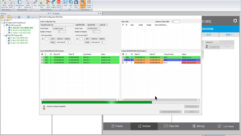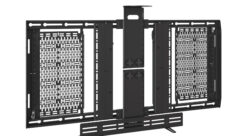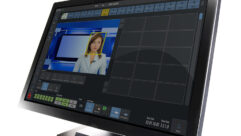Eyes On The Prize: A well intgrated security system is essential to keepingyour clients and their customers safe.
Jan 1, 1998 12:00 PM,
Howard Friedman
Securing a casino requires a degree of organization, commitment andcreativity, which is not always found in traditional securityinstallations. If you were security director of a large Las Vegas orAtlantic City casino, a list of some of your responsibilities would includethe following:
Providing fire safety and evacuation.
Controlling crowds.
Locating and apprehending pick pockets.
Excluding persona non grata.
Eliminating prostitution.
Curbing drunkenness and disorderly conduct.
Promoting safety and preventing accidents.
Maintaining employee identification and staff surveillance.
Controlling access to non-public areas.
If you add to this the need for parking lot and elevator security andconsider the fact that most casinos are in operation all day for every dayof the year, then it is easy to see that the necessary level of vigilancemust continue uninterrupted. Casino security departments are often largeorganizations staffed with three shifts of highly skilled individuals whomust have not only a detailed understanding of the casino’s operation, butalso a strong familiarity with surveillance, access control, securityequipment and emergency measures as well as human nature, diplomacy and lawenforcement. With several hundred patrons and the large amount of cash onhand at any given time, the risk potential is extremely high in the casinoenvironment. Because we hear so little about problems with security,obviously those attending to it deserve significant praise.
Unlike traditional enterprises whose operation functions during structuredbusiness hours, a casino’s doors may never close. Security systems as weknow them – with keypads, door contacts and motion detectors – play only aperipheral role in casino protection. In fact, entrance to a casino’soff-limits areas are governed by access control systems in which only thoseknown to the systems are authorized to carry cards, badges or be otherwiseidentifiable. (See the December 1997 issue of S&VC, “Security Systems ofthe Future,” page 54.)
Closed circuit televisionNonetheless, the essence of casino security is the extensive use of closedcircuit television (CCTV). Depending upon the facility, dozens of camerasare usually housed in ceiling-mounted, dome-shaped enclosures with eachcamera able to be panned up to 360 degrees in addition to being tilted upand down. The domes, normally no larger than is necessary to house one ormore cameras, fully conceal each camera’s movement while affordingsufficient light for ideal image acquisition. Where needed, highlyunidirectional microphones can be positioned to pick up specificconversations that can be used to supplement selected video images.
Casino video systems are elaborate, and they often use hundreds ofthousands of dollars’ worth of switching equipment whose programmablecamera sequences are applied to multiple monitors in the security controlcenter. At the discretion of the operator, a camera’s automated sequencecan be manually overridden and zoomed in or out. Whereas in the past, CCTVsystems required a coaxial wire run between each camera and the switchingcenter, today’s technology incorporates multiplexing, where a singlecoaxial cable can carry multiple camera images to their intendeddestinations. Modern CCTV systems may employ fiber-optic technology, whosecapabilities, in terms of transmission distance and immunity to electricalinterference, far exceed that of even the best coaxially cabledinstallations. Under certain conditions, especially when remote or outdoorcameras are employed, wireless microwave links may be used to transmitvideo images several hundred feet to their appropriate destinations.
Integrated securityStationed within the security center, a remote area manned by up to dozensof people, lies the control apparatus for the cameras, audio pickup, publicaddress capabilities and the communication facilities needed to speak withany security personnel roaming the casino floor. Systems monitoring smokedetectors, fire exits, access control and motion through restricted areasare also incorporated, along with the holdup/panic buttons located indesignated areas on the floor and elsewhere. State-of-the-art-securitytechnology now consolidates all of these diverse components and theirsubsystems into what is known as an integrated security system so that allfactors that jeopardize safety and security – accidents, fire or criminalbehavior – can be processed centrally rather than separately.
Systems integrationThe term systems integration is fairly new to the security industry. Thosesecurity dealers who had earlier combined totally separate security systemsinto a single installation were the forerunners of the modern systemintegrators. They often used the output relay contacts of one system totrigger the input components of another. For example, when opened, a door,protected by a conventional security system, could cause a relay in thealarm control panel to trip, which, in turn, could trigger a time-lapsevideo recorder to capture the images produced by a CCTV camera facing thedoor. In a similar manner, a violation of an access control system couldactivate the alarm output of a standard security system. To do so oftenrequired an understanding of each system’s capabilities, the use ofexternal relay modules and unconventional wire runs, possibly done afterthe fact. This type of arrangement might be acceptable for smaller systems,but for installations involving casino security, only a truly integratedmodern system would be effective.
Systems integration has been referred to as the seamless convergence ofmultiple technologies packaged as a single solution to address the securityneeds of a specific customer. A modern integrated system means that afacility’s video, alarm and access control systems are joined bycentralized methods of display and control, manned every day during whichthe facility is operational. When an incident occurs, each of thesubsystems must act in unison in a predefined manner to contain, controland address the event. For example, when a card reader is accessed or asensor is violated, the system can be made to display the correct camerasautomatically and, if desirable, turn on the intercom in the affected area,allowing the console operator to communicate with a person on the otherend. Alarms can be silenced and access can be remotely controlled by eitheropening a gate in the parking lot or closing fire doors to contain a fire.More simply put, systems integration can provide the convenience of runningone’s card through a card reader and, if properly authorized to do so,automatically disarming the system in specific areas.
Modern integrated systems are highly customized in terms of their hardwareand the software governing their operation. The hardware is made up of manyinput devices (such as card readers, alarm sensors, video cameras andinput/output) and the controller circuit boards linked to each other and tothe software through the auspices of a personal computer or mini-computer.Because all subsystems are under software control, they can also rely upondatabase information (IDs of employees, other individuals having accessbadges, alarm history and facility layout and management) and programmableoperating parameters. Most such systems are operated from a console whosedisplay provides a graphical interface customized to reflect the facility’sfloorplans. (See Figure 1.) Often, all hardware for the system is stored ina common telephone communications room, beneficial from the standpoint ofinstallation and servicing, in which wiring for all alarm points, cameraoutputs, pan/tilt controllers and access control devices can beconveniently homerun.
To be effective, all controllers must talk to each other through the samecommunications protocol. Most use RS-232, but there are often otherprotocols in use by disparate systems, such as RS-422 and RS-485. Thelatter can be used for wire runs of 4,000 feet (122 m), and if extended byphone lines (via modem) or fiber optics, then there should not be apractical limit to the distance over which data can be carried.
The market for integrated systems is often ruled by the cost of doingbusiness and the need to get more for less by reducing operating costs,which often means limiting the number of security personnel required. Manysecurity dealers feel that the rising interest in system integration isbeing driven by downsizing and by the need for businesses to show a largerprofit in periods where sales remain essentially flat.
Time-lapse video recordingMost casinos will record selected video images for closer inspection andfor use as evidence after an apprehension. Because standard video recordersprocess images in real time, they are not practical for surveillance simplybecause too much tape would be required, not to mention the need forperiodic tape changes. As such, real-time recording using T-120 tapes atthe standard VCR speed (SP) would complete a tape every two hours. Thus, acasino’s 24-hour operation would necessitate, for each VCR, 12 tapes eachday, leading to 84 tapes a week and about 360 tapes each month – a realcost and storage difficulty. More significant would be the challenge oflocating and reviewing specific incidents that have been recorded. Eventhrough the use of extended play (EP or SLP), which would reduce thesefigures by a factor of three, a considerable amount of tape would still bein use.
Enter the time-lapse concept, an ideal solution to the tape consumptionproblem. The time-lapse VCR is a special machine that, in effect, can beprogrammed to take periodic frames or snapshots of a scene at selectablerates with the result that far less tape is needed. If set to record oneframe every eight seconds, a very economical mode, a time-lapse recordercan store 960 hours of video on a single T-120 tape. Depending upon thechosen rate, replaying the tape may produce a rapid sequence of picturesrather than fluid motion video. To decrease the amount of time needed toreview any tape, the playback speed can be similarly adjusted. The rate atwhich a time-lapse recorder is set to operate should depend upon the numberof cameras whose images are sequenced through it, the size of the areacovered, and the level of risk involved by not recording continuous images.
Maintaining casino security is an ongoing process, which must consider notonly the safety, orderliness and the legalities of its operation, but mustalso continually investigate new technologies and address the perpetualdesires held by some individuals to defraud others.










